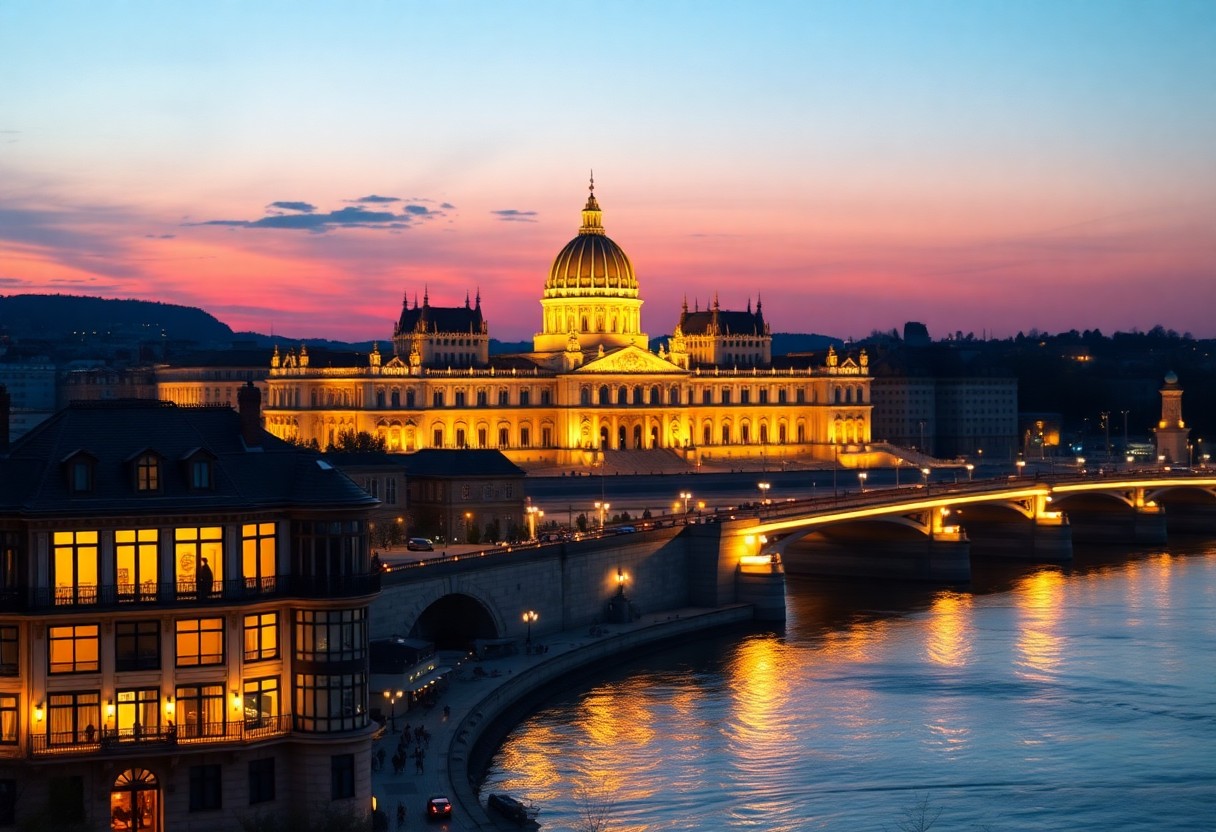There’s something truly enchanting about Budapest that captures your heart from the moment you arrive. As you meticulously plan your city break, you will uncover a vibrant metropolis that artfully combines stunning architecture, rejuvenating thermal spas, and remarkable value for money. Your journey through Hungary’s capital will guide you from the majestic Buda Castle to the iconic Chain Bridge, while your evenings can be spent reveling in the atmosphere of world-famous ruin bars. Whether you opt to stay in the lively Jewish Quarter or the historic Castle District, you’ll find yourself ideally situated to explore the city’s most captivating attractions, all connected by a safe and efficient public transport system.
Discover Budapest's Most Iconic Attractions
As you embark on your Budapest adventure, prepare to be amazed by a city brimming with UNESCO World Heritage sites and striking architectural marvels. The city presents an exquisite blend of historical grandeur and contemporary flair, with must-see attractions scattered across both the Buda and Pest sides of the majestic Danube River. Your exploration will unveil thermal baths, breathtaking architecture, and a lively cultural scene that solidifies Budapest's status as a unique and desirable European destination.
Explore Budapest's Historical Landmarks
Even first-time visitors will be captivated by Budapest’s historical treasures. You’ll discover the majestic Buda Castle perched on its hill, the iconic Chain Bridge that gracefully links the two halves of the city, and the stunning neo-Gothic Parliament Building reflecting beautifully in the tranquil waters of the Danube. These landmarks narrate tales of Hungary’s rich heritage and provide spectacular photo opportunities that you won’t want to miss.
Immerse Yourself in Cultural Sites
Landmarks such as St. Stephen’s Basilica and Heroes’ Square serve as prime examples of Budapest’s deep cultural heritage. You’ll get a sense of the city’s artistic soul at the renowned Hungarian State Opera House and within the many museums that pepper the cityscape. These sites offer invaluable insight into both traditional Hungarian customs and contemporary cultural expressions.
The cultural district of Castle Hill invites you to immerse yourself in the rich history with attractions like the Hungarian National Gallery and the Budapest History Museum. You can wander through medieval streets, visit charming traditional Hungarian cafes, and enjoy panoramic views of the city from the Fisherman’s Bastion. This area frequently hosts cultural events and festivals, ensuring that every visit is a unique experience.

Your Guide to the Best Neighborhoods for Accommodation
When selecting your accommodation in Budapest, it’s essential to consider your location preferences. The city is divided into 23 districts, with Districts V, VI, and VII standing out as the most popular among tourists. Each area presents distinctive experiences, ranging from the historic charm of the Castle District to the bustling nightlife of the Jewish Quarter.
Identifying the Best Areas for Tourists
If you wish to be in close proximity to major attractions, consider staying in District V (Belváros) for luxurious hotels near the iconic Danube River, District VI for boutique hotels nestled around the famous Andrássy Avenue, or District VII for budget-friendly accommodations in the lively Jewish Quarter.
Diverse Accommodation Options to Suit Every Budget
Travelers on a budget will find a wealth of excellent accommodation options in Budapest. Here’s a detailed breakdown of the types of places you can stay:
- Luxury Hotels – Four Seasons, Ritz-Carlton
- Boutique Hotels – Aria Hotel, Brody House
- Mid-range Hotels – K+K Hotel Opera, Prestige Hotel
- Budget Hotels – Ibis Styles, Maverick Hostel
- Apartments – Airbnb options available throughout the city
| Area | Best For |
|---|---|
| District V | Luxury travelers, sightseeing |
| District VI | Shopping, culture enthusiasts |
| District VII | Nightlife, budget travelers |
| District I | History buffs, quiet stays |
| District VIII | Local experience, value seekers |
 Here’s the organized content for your blog post sections:
Here’s the organized content for your blog post sections:
Essential Travel Tips for Your Budapest Adventure
As you prepare for your Budapest adventure, proper planning is crucial. Here are some key points to keep in mind:
- Always exchange money at official currency exchange offices to avoid unfavorable rates
- Purchase a Budapest Card for complimentary public transport and access to numerous museums
- Ensure your valuables are secure, particularly in tourist hotspots where pickpockets may operate
- Book visits to thermal baths in advance, especially during peak tourist seasons
- Carry small denominations of Hungarian Forint for purchases at local shops
Remember to wear comfortable walking shoes as you explore the city’s picturesque hills and charming cobblestone streets.
Efficient Transportation Options in Budapest
Exploring Budapest is a breeze thanks to its highly efficient public transport system. The metro network conveniently connects all major attractions, while trams and buses provide scenic routes throughout the city. For the best value, consider purchasing a 72-hour travel card for unlimited rides. Ticket machines are available at all stations, equipped with English language options for your convenience.
Optimal Times to Experience Budapest
When planning your visit, consider that March to May and September to November offer the most pleasant weather along with fewer crowds. During these months, you can enjoy moderate temperatures that are ideal for sightseeing and outdoor activities. Accommodation rates are generally more affordable during these shoulder seasons.
Public transport operates from 4:30 AM until 11:30 PM. The summer months (June-August) can become very hot and crowded, while winter (December-February) brings festive Christmas markets but also cold temperatures. Spring is celebrated with the Budapest Spring Festival, while autumn showcases breathtaking colors in City Park.

Crafting Your Ideal Budapest Itinerary
After determining your travel dates, creating a well-structured itinerary will maximize your Budapest experience. Your schedule should encompass must-see attractions like Buda Castle, Fisherman’s Bastion, and the renowned thermal baths. Be mindful of your accommodation’s location and plan daily routes that group nearby attractions together, saving both time and energy.
Recommendations for Visit Duration
While some travelers can manage to see Budapest’s main attractions in just 3-4 days, a stay of 5-7 days is ideal for a thorough exploration. This timeframe allows you to visit key sites, indulge in thermal baths, and fully immerse yourself in local culture without feeling rushed. You’ll also have the flexibility to incorporate spontaneous discoveries into your journey.
Suggested Itinerary Routes for Optimal Exploration
By organizing your days based on duration, you can navigate your visit more efficiently. Begin your adventure in the Castle District on day one, delve into the Jewish Quarter on day two, and dedicate day three to City Park and Heroes’ Square. In the evenings, don’t miss out on riverside strolls and delightful dinner cruises.
The most effective way to explore the city is by balancing your time between Buda and Pest. Mornings are perfect for visiting popular sites to avoid crowds. Plan your thermal bath experiences for the late afternoon, allowing you to unwind after a day of exploration. Utilizing the efficient public transport system will make moving between locations seamless.
Here’s the formatted practical information section for your Budapest blog post:
Essential Practical Information for Your Trip
Everything you need to know for your Budapest visit: The city operates using the Hungarian Forint (HUF), with major credit cards widely accepted. Public transport is available from 4:30 AM to 11:30 PM, and reliable night buses are accessible for late-night travel. The best times to visit are between March-May and September-November when crowds are smaller and prices are more reasonable.
Smart Budget Planning for Your Trip
Practical daily budgets typically range from 15,000-45,000 HUF ($45-135). Budapest offers outstanding value for money compared to many other European capitals. Your primary expenses will include accommodation ($30-150), meals ($10-30 per day), and transport ($2 per ride). Notably, many attractions provide free entry on the first Sunday of each month, allowing you to save money.
Cultural Etiquette and Local Customs
Here are some practical tips for navigating local etiquette: Tipping 10-15% is customary in restaurants. Always greet people formally, particularly older residents. Avoid consuming alcohol on the streets as it is prohibited. Public displays of affection are generally acceptable but should remain modest.
Given that Hungarian culture places a high value on politeness and formalities, it is advisable to address individuals using their titles and surnames until they invite you to use their first names. Always greet shopkeepers upon entering. It is also customary for Hungarians to remove their shoes when entering homes, and you should follow this tradition if visiting local residents. Punctuality is greatly appreciated in both business and social contexts.
Uncovering Budapest’s Hidden Gems and Local Experiences
Many travelers overlook Budapest’s authentic side, often hidden beyond the well-trodden tourist paths. You’ll find secret thermal baths frequented by locals, underground art galleries, and tranquil courtyards where time seems to stand still. Your exploration may include the captivating street art of the Jewish Quarter and the hidden ruin bars that reflect the city’s vibrant creative spirit.
Exploring Off-the-Beaten-Path Attractions
Discovering lesser-known spots reveals the true character of Budapest. You can visit the Béla Bartók Memorial House, explore the whimsical Pinball Museum, or stroll through the serene Károlyi Garden. These locations provide authentic experiences away from the throngs of tourists, allowing you to perceive the city through the lens of its residents.
Indulging in Local Food and Drink Experiences
Experiencing local dining establishments will enhance your understanding of the rich tapestry of Hungarian cuisine. You’ll discover traditional food markets, family-run restaurants, and cozy wine cellars where you can savor authentic dishes and exquisite wines. The food scene in the seventh district offers modern interpretations of classic Hungarian recipes.
A visit to Budapest’s culinary hotspots should include stops at the Rákóczi Market for fresh produce and street food, iconic coffee houses like Ruszwurm (established in 1827), and the wine bars of Buda. Each neighborhood presents its own culinary identity, ranging from hearty Hungarian classics to innovative fusion restaurants.
Final Thoughts on Your Budapest Journey
With all this information, you can confidently plan your city break in Budapest. Your time spent in this magnificent city will be richly rewarding as you explore the grand Buda Castle, unwind in soothing thermal baths, and stroll across the illustrious Chain Bridge. You may choose to base yourself in District V for luxurious accommodations near St. Stephen’s Basilica or opt for the Jewish Quarter for an immersive nightlife experience and cultural engagement. By visiting these iconic attractions and staying in your chosen neighborhood, you’ll experience the best of Budapest’s vibrant heritage and modern allure.
Your Questions Answered: FAQ
What are the must-visit attractions in Budapest for a city break?
Essential attractions in Budapest include Buda Castle for its royal history and breathtaking views, Széchenyi Thermal Bath for relaxation, and St. Stephen’s Basilica for its architectural splendor. The Parliament Building offers guided tours, while the Chain Bridge is perfect for memorable photo opportunities. The Central Market Hall allows visitors to sample traditional Hungarian cuisine and purchase local goods.
Where are the best areas to stay in Budapest for tourists?
District V (Belváros) is ideal for first-time visitors, providing easy access to major attractions and a variety of dining options. District VI features luxury hotels near Andrássy Avenue and the Opera House. District VII (Jewish Quarter) caters to budget travelers and nightlife aficionados, boasting numerous hostels and lively bars. Each area is well-connected by public transport to key tourist sites.
What is the best time to visit Budapest for a city break?
The most favorable months to visit are from March to May and September to November, as they provide mild weather and fewer tourists. Summer (June-August) brings warmer temperatures but also larger crowds and elevated prices. Winter (December-February) includes festive Christmas markets and enjoyable thermal baths, though temperatures may dip below freezing. Spring and fall offer comfortable conditions for walking tours and outdoor enjoyment.
The Article: Budapest city breaks best attractions and where to stay appeared first on https://rentacar24.org/





Comments are closed